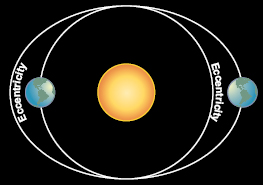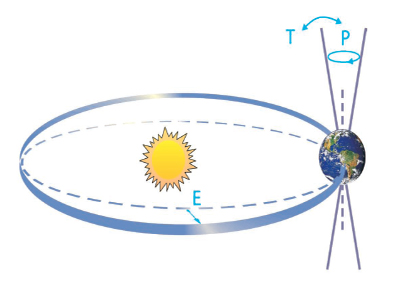
Precessions
Earth wobbles on its axis about once every 26,000 years, similar to a spinning top. This alters the relationship between the solstices and the distance from Earth to the Sun.
For example, 11,000 years ago the Northern Hemisphere summer solstice occurred at perihelion, when the Earth is closest to the Sun, almost the exact opposite of current seasons. This "synching up" of summertime with perihelion made the differences between winter and summer much more pronounced.
The phenomena of the solstices and equinoxes creeping slowly forward through the calendar year is now known as precessions.

Eccentricity
Eccentricity refers to the extent to which the Earth's orbit around the Sun departs from a perfect circle. Changes in orbital eccentricity affect the Earth-sun distance and solar insolation.
Earth's orbit changes from being elliptical (high eccentricity) to being nearly circular (low eccentricity) in a cycle that takes about 100,000 years. When the orbit is highly elliptical, seasonal increases in solar energy is substantial, resulting in a very different climate from what we experience today.
At present the maximum difference between Sun-Earth distances during the year is only about 3% but over this number has been as small as 1% (a nearly circular orbit) and as large as 11%.

Axial Tilt
The tilt of the Earth also changes slightly, with a dominant cycle every 41,000 years. Even though the variation in angle of inclination is only about 1 degree, it causes large differences in solar radiation and therefore is a critical climate factor.
Today the Earth's axial tilt is about 23.5 degrees, which largely accounts for our seasons.
Changes in Earth's angle with respect to the Sun often go by the name "obliquity".

Cycle Resonance
Similar to overlapping musical tones, the Milankovitch cycles advance and interact simultaneously, creating resonances that are not quite the same as the original cycles. The result is that Earth's climate records reflect four different periodicities due to variations in orbit and tilt at 19,000, 23,000, 41,000 and 100,000 years.
